Slovaks against fascism. National uprising and fighting on the side of the Red Army
Perhaps the most famous national formation in the Red Army, who heroically participated in the Great Patriotic War, was French aviation Regiment "Normandy - Neman". However, in addition to the French pilots, Polish, Czechoslovak, Romanian, Hungarian, Yugoslav units and individual volunteers fought on the side of the Red Army. In this article we will talk about how much the Slovaks contributed to the victory over Nazi Germany - the participants in the Slovak national uprising, the partisan movement in the Carpathians and the Czechoslovak units who fought on the side of the Red Army.
Twenty years of the Czechoslovak Republic
The emergence of Czechoslovakia as a sovereign state was due to the defeat of Austria-Hungary in World War I and the subsequent collapse of the Hapsburg empire into several independent states. Before 1918, the Czech Republic for several centuries had no sovereignty and was part of the Hapsburg Empire. Such a long stay under the rule of the German dynasty affected the socio-cultural specifics of the development of Czech society. A significant part of the Czech elite was “Germanized”, adopted the German language and German culture, which adversely affected the national culture of the Czech Republic. As for Slovakia, it has been part of the Hungarian kingdom since the 11th century, and then entered the Hapsburg Empire. Thus, by the end of the First World War, both the Czech Republic and Slovakia had no traditions of their own statehood for a very long time.
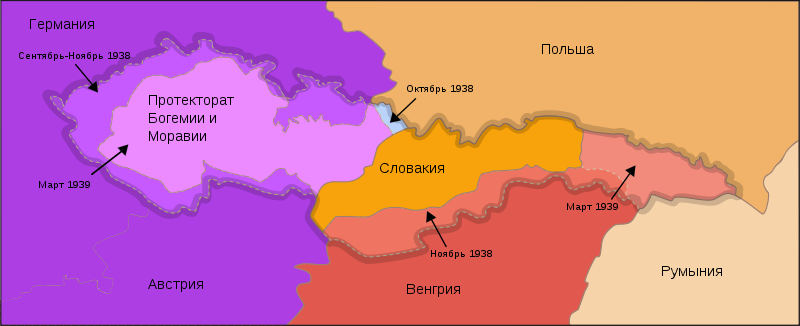
The political independence of Czechoslovakia as a unified state, which included the Czech Republic and Slovakia, and then Subcarpathian Russia, was proclaimed 28 October 1918 Borders Czechoslovakia were established in the 1920 Czechoslovak Constitution. Created thanks to the support of the Entente, Czechoslovakia remained throughout the 1920's — 1930's. perhaps the most democratic country in all of Eastern Europe. When authoritarian regimes were established in Poland, Hungary, Romania, Bulgaria, Albania and other states of the region, including those of pro-fascism, Czechoslovakia remained a “reference model” of democratic statehood, and this gave it reason to hope for the full support of Britain, France and the United States. As it turned out, Czechoslovak political leaders miscalculated. The leading Western powers did not hinder the impending attack on Czechoslovakia by the gaining power of Nazi Germany and allowed the actual destruction of Czechoslovak statehood. After the invasion of 1938 by the German troops into the country, the territory of the Czech Republic became part of the Protectorate of Bohemia and Moravia, Slovakia declared independence and became a puppet state with the pro-Hitler regime of Tiso, and Subcarpathian Russia after a short resistance was annexed to Hungary.
Glinkovtsy - satellites of Hitler
The creation of an independent Slovakia under the patronage of Hitler's Germany was the result of many years of political activity of the Slovak separatists who dreamed of secession from Czechoslovakia, within which the Slovaks occupied a secondary position. In Slovakia, the Slovak People’s Party, which adhered to clerical-nationalist positions, was very popular. At the beginning of its political activities, even before the First World War, this organization was a usual right-wing conservative party that advocated “Slovak traditional values”, but in 1920 and especially in 1930, its gradual drift began. towards fascism. At the source of the Slovak People’s Party was priest Andrei Glinka (1864-1938), a fiery supporter of the full political independence of Slovakia as a Catholic traditionalist state.
After Glinka’s death, he was also replaced by priest Joseph Tiso (1887-1947), and the party in honor of Glinka was named the Glinka Slovak National Party. In the same 1938, along the lines of the fascist and Nazi assault detachments, the so-called “Glinkov Guard” (Glinkova Garda) was created with the party, which was a militarized formation that included all young men who were members of the party and fit for military service . Gradually, Glinkova Garda began to perform police functions, played a major role in organizing the persecution and extermination of Jews, Gypsies, Czechs, Communists and Protestants (Catholic fundamentalists from the Glinka Slovak Popular Party fought not only Jews, Gypsies and Communists, like German Nazis, but also Protestants and Orthodox, who were considered alien to the Slovak national spirit). In 1938 of Glinkov, the Slovak People’s Party was renamed the Party of Slovak National Unity.
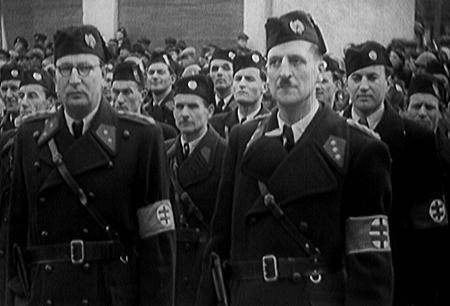 The immediate responsibility for the deportation of Slovak Jews, the annihilation of communists, the repression against Protestants and Orthodox in Slovakia was borne by the commander of the Glinka Guard, Alexander Mach (1902-1980). From the age of twenty, from 1922, this Slovak Nazi participated in the activities of the people's party, where he made a good career, and in 1940-1945. served as Minister of the Interior of Slovakia. Moreover, his candidacy for this position was supported by Adolf Hitler himself, who influenced President Tiso’s decision to appoint a new Minister of the Interior.
The immediate responsibility for the deportation of Slovak Jews, the annihilation of communists, the repression against Protestants and Orthodox in Slovakia was borne by the commander of the Glinka Guard, Alexander Mach (1902-1980). From the age of twenty, from 1922, this Slovak Nazi participated in the activities of the people's party, where he made a good career, and in 1940-1945. served as Minister of the Interior of Slovakia. Moreover, his candidacy for this position was supported by Adolf Hitler himself, who influenced President Tiso’s decision to appoint a new Minister of the Interior. Slovak conservatives sought to enlist the support of the Italian fascists and the German Nazis, with the aim of which they gradually radicalized the program and practice of their party. In the end, the Slovak nationalists managed to achieve their goal - after the partition of Czechoslovakia in 1938, a formally independent Slovak republic was created, which practically completely followed in the wake of German foreign policy, and in domestic policy was guided by the recommendations of “big brother” - Hitler's Germany.
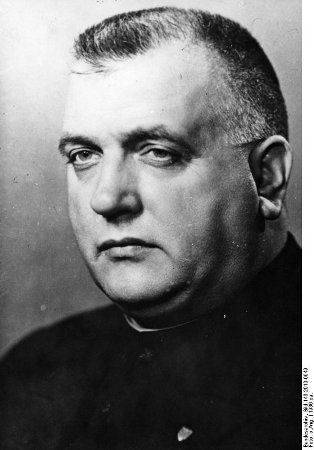 President of the Republic became Josef Tiso. 24 November 1940. Slovakia became an ally of the “axis” - Germany, Italy and Japan. When Adolf Hitler began preparations for a war with the Soviet Union, Joseph Tiso turned to the Führer with a proposal for the participation of the Slovak armed forces in the attack on the USSR.
President of the Republic became Josef Tiso. 24 November 1940. Slovakia became an ally of the “axis” - Germany, Italy and Japan. When Adolf Hitler began preparations for a war with the Soviet Union, Joseph Tiso turned to the Führer with a proposal for the participation of the Slovak armed forces in the attack on the USSR. It is noteworthy that the Führer and the German military command were very skeptical of this proposal. First, the Führer did not trust the Slovaks, fearing that due to their belonging to the Slavic world they would not fully fight the Soviet army, the Russians. Secondly, the German military command had a very low opinion of the fighting qualities of the Slovak armed forces. And, it should be noted, the representations of the generals of the Wehrmacht were not far from the truth - as the events of the near future showed, the Slovak units practically could not fight with the Red Army. However, 23 June 1941 of the year
Slovakia declared war on the USSR, and 26 on June 1941 against the Red Army was sent to the Slovak expeditionary force. By the way, shortly before Slovakia supported the German invasion of the Soviet Union, the USSR recognized the independence of Slovakia - only a few sovereign states of the then world recognized the disintegration of Czechoslovakia and Slovak statehood. Of course, among them were Germany and its allies on the axis, the Catholic Vatican, which supported the clerical party of Tiso, Lithuania, Estonia, Spain, Switzerland, El Salvador and Manzhou-Go. A year later, Joseph Tiso "thanked" the Soviet state by taking part in the treacherous attack of the Nazis in the Soviet Union.
Slovak army on the eastern front
On the eve of World War II, the Slovak army consisted of three infantry divisions and auxiliary units. A brigade of the Slovak army with a total of thousands of soldiers and officers in 3,5 was sent to the eastern front. The brigade was armed with Czechoslovakia. weaponleft in military warehouses and after the partition of Czechoslovakia given to the Slovak armed forces. The brigade joined the battle in the first days of the war and was almost immediately defeated, confirming the fears of the Hitler generals about the low fighting qualities of the Slovak armed forces. After the defeat of the brigade, the Slovak troops were focused on the fight against partisans and the security service. A reinforced motorized brigade of 10 000 military personnel and a guard division of 8 500 military personnel were deployed on the territory of Ukraine and Belarus. However, as the Wehrmacht "bogged down" in the territory of the Soviet Union and suffered serious losses, the Slovak troops again sent to the front. From December 1941 to July 1942, the Slovak Brigade, commanded by Major General Augustus Malar, fought on the Mius Front. She participated in the attack on Rostov-on-Don, then fought in the Kuban. At Stalingrad, the Slovak brigade suffered a serious defeat and, losing all artillery and armor, retreated through Kerch to the Crimea. Here the brigade, reorganized into the First Slovakian Infantry Division, participated in the defense of the Crimean coast.
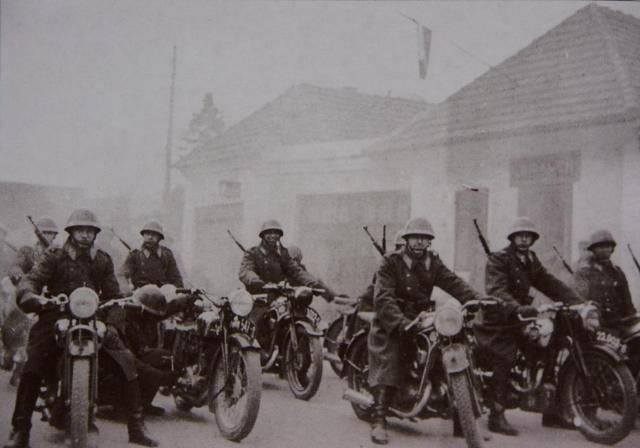
Despite the fact that the Tiso regime in every way demonstrated its loyalty to Hitler and tried to show the usefulness of Slovakia and the Slovak army for the Nazi regime, completely different sentiments prevailed among the personnel of the Slovak units on the eastern front. For most Slovaks - officers, and, especially, mobilized soldiers - it was "not their war." The Slovaks sympathized with the Russians, frankly did not want to fight and, at any opportunity, deserted or surrendered to entire units. A significant number of Slovak servicemen contacted the partisans and underground fighters in the occupied territories and replenished their ranks, or carried out the assignments of the Soviet underground, remaining in service in their units. Thus, in Rostov-on-Don, in the occupation of which Slovak units from the Malar brigade also took part, Slovak soldiers Iosif Tokach, Richard Kanya and Jan Gatsdosch took part in the work of the local underground organization “Yugovtsev”. Moreover, Gatzdoschik wore shoulder straps for a second lieutenant of the Slovak army, which did not prevent him from carrying out the tasks of the Rostov underground perfectly. In August 1943, the Slovak units were concentrated, on the orders of the German command, on the defense of Perekop, and part of the Slovak division went to the defense of Kakhovka. Here the Slovaks were defeated by the advancing Red Army. Virtually the entire personnel of the First Slovak Infantry Division moved to the side of the Soviet Union. The Slovak units that remained loyal to the Tiso regime had practically lost their combat effectiveness — they were constantly being reduced due to the massive desertion of their fighters. Having retreated to the territory between the rivers Bug and Dniester, the Slovak troops under the command of Colonel Karl Peknik, were engaged in carrying out security services and continued to decline in number. Slovak soldiers deserted and joined the partisan detachments. In the end, the German command decided to withdraw the remnants of the Slovak army to the territory of Romania, Hungary and Italy and use them only for construction and economic work.
Total on the territory of the Soviet Union in 1941-1944. 36 fought thousands of thousands of Slovak soldiers and officers. 27 of thousands of Slovak military personnel during this time surrendered to the Red Army. In fact, 75% of Slovak soldiers and officers refused to fight on the side of Nazi Germany - such indicators, perhaps, did not give any other army from among the Allied states of the Third Reich. While the most effective, as it seemed to President Tiso, the Slovak troops were on the eastern front, underground activities under the leadership of the Czechoslovak Communists did not cease on the territory of Slovakia itself. Back in the summer of 1943, Karol Schmidke (1897-1952), a prominent leader of the Czechoslovak Communist Party, penetrated the territory of Slovakia. The leadership of the Central Committee of the Communist Party of Czechoslovakia set itself the task of deploying an underground anti-fascist movement in Slovakia.
Slovak National Uprising
When 12 August 1944, in connection with the approach of the Soviet troops to the Slovak border, President Josef Tiso imposed martial law in the country, the famous Slovak national uprising began. By this time, an army corps was stationed in Slovakia, numbering 24 thousands of soldiers and officers. It was in his divisions that the plot against the Tiso regime was ripe. The organizers of the uprising of the National Council of Slovakia planned that the corps units would occupy the rear of the German troops strategically important Carpathian peaks and free up the paths for the passage of the Red Army.
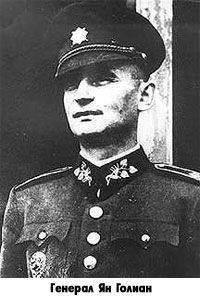 In total, up to 60 000 military personnel of the Slovak army, 15 thousands of Czechoslovakia and 3 thousands of Soviet partisans participated in the Slovak National Uprising. At the first stage, the uprising was led by Lieutenant Colonel Jan Golian, who served in the elite "Rapid Division". Later the uprising was led by divisional general Rudolf Viest who arrived in Czechoslovakia. The troops that had gone over to the side of the uprising were divided into six groups. The first group “Krivany” in Banská Bystrica operated under the leadership of Lieutenant Colonel Josef Tlah. The second group Fatra, which operated in Brezno, was led by Colonel Mikhail Shirits, the third group by Gerlach, which operated in Zvolen, was led by Colonel Pavol Kun and Colonel Mikulas Marcus. In Prievidze, Handlov and Kremnica, the fourth Muran group operated under the command of Colonel Mikulas Marcus and Lieutenant Colonel Jan Malar. The fifth group of “Dumbier”, commanded by Lieutenant Colonel Emile Percot, was concentrated in Drazhkovce and Lupce. The sixth group "Zobor" operated in Liptovsk Osade under the command of Colonel Jan Chernek. Aviation rebels commanded by Major Joseph Toth.
In total, up to 60 000 military personnel of the Slovak army, 15 thousands of Czechoslovakia and 3 thousands of Soviet partisans participated in the Slovak National Uprising. At the first stage, the uprising was led by Lieutenant Colonel Jan Golian, who served in the elite "Rapid Division". Later the uprising was led by divisional general Rudolf Viest who arrived in Czechoslovakia. The troops that had gone over to the side of the uprising were divided into six groups. The first group “Krivany” in Banská Bystrica operated under the leadership of Lieutenant Colonel Josef Tlah. The second group Fatra, which operated in Brezno, was led by Colonel Mikhail Shirits, the third group by Gerlach, which operated in Zvolen, was led by Colonel Pavol Kun and Colonel Mikulas Marcus. In Prievidze, Handlov and Kremnica, the fourth Muran group operated under the command of Colonel Mikulas Marcus and Lieutenant Colonel Jan Malar. The fifth group of “Dumbier”, commanded by Lieutenant Colonel Emile Percot, was concentrated in Drazhkovce and Lupce. The sixth group "Zobor" operated in Liptovsk Osade under the command of Colonel Jan Chernek. Aviation rebels commanded by Major Joseph Toth. On August 23, 1944, Slovak President Josef Tiso formally asked Adolf Hitler to help suppress the rebellion. On August 31, SS Obergruppenführer Gottlob Berger was appointed head of the SS and police of Slovakia. Abvergruppa-218 was subordinate to him, which included a detachment of 25 German soldiers, a detachment of 220 Slovaks in German service, a detachment of 45 Cossacks, and a detachment of 45 Caucasians. Berger also commanded units tank the Tatra divisions, the ильiel and Schafer combat groups, and parts of the Slovak fascists from the Glinka Guard. After Bergera was replaced on September 14 by SS Obergruppenführer and police general German Hefle, reinforcements were sent to Slovakia.
27 August 1944. Slovak troops killed an 22 German officer, and an uprising started in central Slovakia at the same time. The rebels seized the Minister of Defense of Slovakia, General Joseph Turanz, and handed him over to the Soviet side. All the air forces of Slovakia led by Major Trinka, who was in command of the aviation regiment, went over to the Soviet side. It is significant that the famous General Augustine Malar, whom the Germans awarded the Iron Cross for participating in hostilities on the eastern front, also did not prevent the majority of his soldiers and officers from moving to the side of the uprising. For two months, the rebels kept Dukle Pass, where battles of German and Soviet troops were fought. Only 18 in October 1944, the three German divisions managed to go on the offensive in the position of the Slovaks, using the help of militias from among the local Germans. The victims of the Wehrmacht and SS punitive operations were no less than 25 000 Slovaks. Among the dead was General Augustine Malar, who ended his life in a concentration camp.
The Soviet Union provided comprehensive assistance to the Slovak National Uprising. Thus, the communist leaders of Czechoslovakia, Rudolf Slansky and Jan Sverma, were abandoned from the USSR to the territory of Slovakia, and later began a massive cast into the Slovak territory of small reconnaissance and sabotage groups of 10-12 trained soldiers in each. These groups were supposed to play the role of the “core” of the Slovak partisan movement being formed. So, on the basis of a group of 11 people, commanded by Soviet officer Peter Velichko, the 1-I Stefanik Slovak Partisan Brigade was created, in the ranks of which 889 Slovaks fought, 325 citizens of the Soviet Union and 220 French citizens. On the basis of a group of paratroopers under the command of Alexei Egorov, a three-thousandth partisan brigade emerged, which destroyed bridges and communications, attacking enemy columns. The 2-I Czechoslovak Partisan Brigade was established in August 1944 on the basis of a partisan detachment commanded by Haim Korentsvit (partisan pseudonym - Evgeny Volyansky). Volyansky detachment seized a strategically important airfield in the area of the city of Sveti Mikulas, which was used for landing air transport from the Soviet Union with reinforcements, weapons and ammunition. After the suppression of the uprising, Volyansky at the head of his brigade was able to get out of the encirclement of the Nazis, but he froze both feet. Most rebels were less fortunate - before 30, 000 people were in concentration camps. The surviving part of the rebels launched partisan resistance in the Carpathian Mountains. To suppress the partisan movement in the Carpathians, the SS division "Galicia", staffed by volunteers from Galicia, was thrown. Galicians staged a real terror in the Slovak villages, mocking civilians. Many villages were burned, and among the Slovaks “Galicia”, like other parts of the SS, was called “the most scum”.
On the part of Hitler's Germany, 30, thousands of servicemen, two tank divisions and air units participated in the suppression of the uprising. However, the success of the rebels was obvious. Not only did they restrain considerable enemy forces for a long time, but both Slovakia’s defense minister generals Turanets and Ferdinand Chatlos were taken prisoner by the rebels. In battles with the rebels, 10 350 of German soldiers was killed. Hitlerite army lost 100 artillery shells, 2 armored trains, 30 armored vehicles, 1000 vehicles.
Czechoslovakia on the side of the Red Army: from the battalion to the corps
In addition to participating in the uprising and guerrilla warfare on its own territory, the Slovaks fought as part of the Czechoslovak units formed in the Soviet Union. Back in May, 1941, before Hitler attacked the Soviet Union, an agreement was reached on an alliance between the USSR and the government of Czechoslovakia in exile. In accordance with this agreement, the Soviet Union authorized the formation of Czechoslovak armed forces on Soviet territory. 27 September 1941 was allowed the creation of the Czechoslovak infantry battalion, and 5 January 1942 in Buzuluk began its formation. It was based on former soldiers of the Czechoslovak Legion, an armed unit created in March 1939 on the territory of Poland from among former soldiers and officers of the Czechoslovak army who left the country after the occupation of the Czech Republic by the Nazis. The defeat of Poland forced the Czechoslovak legionaries to retreat to the territory of the Soviet Union, where they were in the status of internees. Most of the legionnaires still in 1940, went to France - to fight against fascism on the western front. However, a number of Czechoslovak troops remained in the Soviet Union, and in 1941, they became part of the formed infantry battalion. But the number of legionaries who were in the USSR was not sufficient to form a full-fledged battalion, therefore 3 February 1942 The USSR State Defense Committee decided to grant an amnesty for all Czechoslovak citizens who were on Soviet territory. 19 November 1942. An amnesty was also announced for all Slovaks and Carpathians from Hungary, who had previously lived in the territories that were part of Czechoslovakia, but were cut off from her in 1939 in favor of Hungary.
At the beginning of 1943, the number of the battalion was 974 man, among them 26 officers, 10 captains (in the Czechoslovak army “captainers” is a special category between officers and non-commissioned officers, similar in their functional duties to Soviet and Russian ensigns and midshipmen), 244 non-commissioned officer and 694 privates. If we talk about nationality, then among the soldiers were Czechs, Slovaks, Rusyns and Jews. The battalion servicemen wore a British uniform with pre-war Czechoslovak symbolism and were armed with Soviet small arms. The battalion was armed with, in addition to small arms, 12 Maxim machine guns, 18 mortars and 2 45-mm guns.
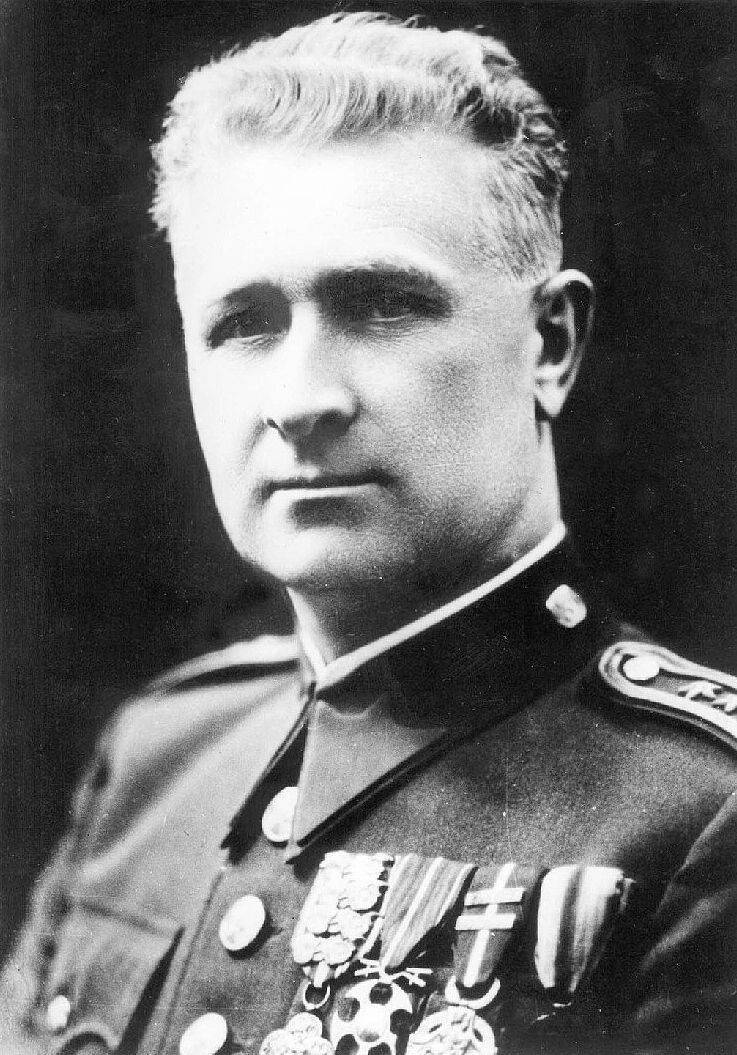
Colonel Ludwik Svoboda
The commander of the 1 th Czechoslovak battalion became a lieutenant colonel (then a colonel and general) Ludwik Svoboda. He was no longer so young — in 1942, when the formation of the battalion began, Freedom, born in 1895, turned 47. In his youth, Freedom learned as an agronomist, but circumstances forced him to connect his future life with the army. In 1915, Liberty was drafted into the Austro-Hungarian army, participated in hostilities on the Eastern Front, but voluntarily surrendered, not wanting to fight against the Russians. After being captured, he spent some time in a prisoner of war camp, then served as a fire brigade in Kiev, joined the Czechoslovak Legion, where he commanded a platoon and a company. After the revolution, he participated in battles against the Red Army - again, as the commander of a company, and then a battalion of the Czechoslovak Corps. In 1920, Svoboda returned to his homeland and served as a captain in the Czechoslovak army. In 1923-1931 he served as commander of a machine-gun company and deputy commander of an infantry battalion in the 36 infantry regiment stationed in Uzhgorod (now the Transcarpathian region of Ukraine), in 1931-1934. taught Hungarian at the military academy, in 1934-1938. was the deputy commander of the infantry battalion, and from September 1938 to March 1939 - commander of the infantry battalion.
As an opponent of the German occupation, he was dismissed from the army and fled to Poland, where he participated in the creation of the Czechoslovak Legion. The first Czechoslovak Infantry Battalion to March 1943 was included in its membership 3 infantry companies, a machine-gun company, a company of mortar, anti-tank company, subsidiary company, management squad, ambulance squad, economic platoon, detachment of the field gendarmerie platoon machine gunners, combat engineer platoon, communications platoon . The battalion was under the operational control of the 25 Guards Rifle Division of the 3 Tank Army, and then the 62 Guards Rifle Division of the 3 Tank Army. The combat successes of the battalion contributed to the high appreciation of its combat readiness on the part of the Soviet command. The courage shown by Czechoslovak soldiers and officers in the battles against the Nazi troops influenced the decision to create the 1-th separate Czechoslovak infantry brigade. The creation of the brigade was announced on 5 in May on 1943, and on May 10 began its formation. The commander of the brigade was Ludwik Svoboda. The number of the brigade was growing rapidly. In September, 1943 3 military personnel served in it. The national composition of the brigade changed - contrary to the name, it was rather not a “Czechoslovak” but “Ruthenian”: from 500 3 soldiers and officers more than 500 2 servicemen of nationality were Rusins - natives of Subcarpathian Rus. Also in the brigade were 200 Czechs, 560 Slovaks, 340 Jews and 200 Russians. Later, the number of the brigade was increased by 160 thousand people - again, at the expense of the Rusyns. By 7, the brigade consisted of 1945 15 military personnel, of which more than 000 11 were Rusyns. After the liberation of Transcarpathia, it was there that the main recruitment service for the brigade was carried out.
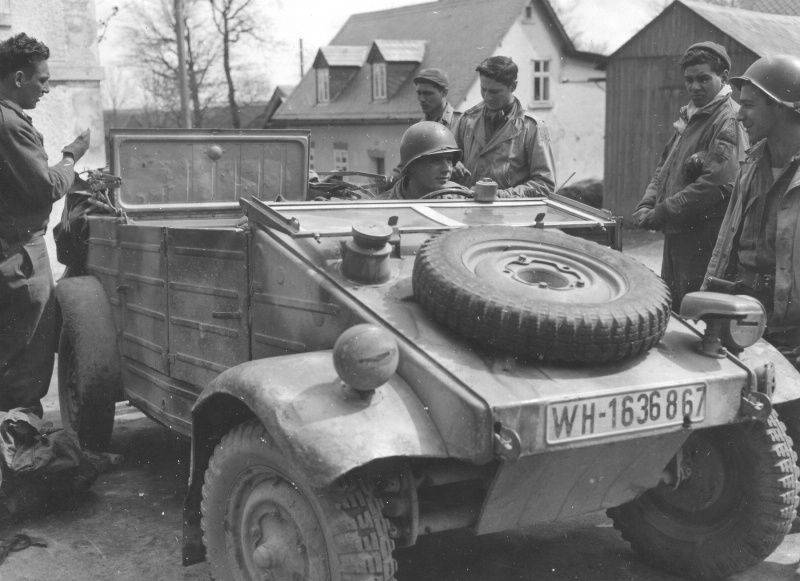
10 April 1944, on the basis of the 1th Separate Czechoslovak Infantry Brigade, the formation of the 1th Czechoslovak Army Corps began. The structure of the housing includes 1-I and 3-Czechoslovak infantry brigade, 2-I independent Czechoslovak airborne brigade, armored regiment, artillery, anti-aircraft artillery and anti-tank artillery regiment, communications battalion, an engineering, automotive, medical and sanitary battalion. In addition, in August 1944 a tank brigade of 65 tanks was created, and two months earlier, in June 1944, a Czechoslovak Fighter Aviation Regiment on 32 aircraft. In December 1944, the number of Czechoslovak aviation units increased to an aviation division on 99 aircraft comprising 2 fighter and 1 assault aviation regiments. The recruitment of personnel was carried out by mobilizing the Ruthenian and Slovak population in the liberated areas of Transcarpathia.
Slovak paratroopers: 2-I airborne partisan
There was a whole brigade in the 1 of the Czechoslovak Army Corps story the occurrence of which is directly related to the mass cases described above of the transfer of Slovak soldiers and officers to the Soviet side. In December, in the Melitopol area, 1943, the entire First Slovakian Infantry Division passed over to the Soviet side - almost at full strength, with private soldiers, non-commissioned officers and officers. The Soviet military command decided to create a separate combat unit on the basis of the Slovak division, which could solve operational tasks. 7 January 1944 in the town of Efremov, Moscow Region, began the creation of an airborne brigade along the lines of Soviet airborne units. The commander of the brigade was appointed Colonel Vladimir Przhikryla. For three months, soldiers and officers selected as part of a brigade underwent an airborne and special training course, during which it was found that most of the Slovak soldiers from the infantry division could not serve in airborne units . Nevertheless, the personnel continued to train, and officers were trained in special schools in Buzuluk and Veseloi. 17 April 1944 brigade was named 2-th separate Czechoslovak airborne brigade, and on April 23 brigade was presented with a battle standard and it was incorporated into the 1-th Czechoslovak army corps. Parts of the brigade participated in the Carpathian-Dukla operation, losing 143 soldiers killed and 438 wounded in eight days of fighting, 47 fighters went missing. Such large losses caused the immediate withdrawal of the brigade to the rear. However, in October, Czechoslovak politicians appealed to the leadership of the Soviet Union with a request to send military units to the aid of the Slovak National Uprising. The choice of the Soviet command fell on the 2 th Czechoslovak airborne brigade, because, firstly, it was staffed mainly by Slovaks, and secondly, it had a corresponding training profile. The brigade was transferred to airfields occupied by Slovak partisans in the Banski Bistrita area. The brigade included instructors and saboteurs from the state security divisions. 53 guerrilla groups of 15-20 experienced guerrilla commanders and instructors each were sent to Slovakia. Thanks to the airborne brigade that arrived to help the rebels, the position of the rebel Slovaks improved, but the brigade was unable to turn the tide of the events and prevent the German uprising from crushing the uprising. Therefore, it was reorganized during the Czechoslovak Partisan Brigade 2 and continued its activities, spreading in small groups over the territory of Slovakia, primarily in the Carpathian Mountains.
Soldiers and officers of Czechoslovak units demonstrated a high level of courage and military training. Apparently this was one of the reasons for the fierce hatred that the Nazis had for the servicemen of the Czechoslovak formations who fought on the side of the Soviet Union. Although, it is even more likely that the Nazis in Czechoslovakia saw traitors who had gone over to the side of the enemy. Over 1943-1944 Czechoslovak Corps lost 4 011 people dead, missing and dead from injuries, 14 202 people were injured. Czechoslovak soldiers and officers captured, most often did not survive - the Germans subjected them to brutal torture and harassment. It is a fact that the Germans hung up five Czechoslovak prisoners of life alive upside down, cutting off their ears, noses and tongues. During the liberation of Slovakia in 1945, the Germans burned alive prisoners of war from Czechoslovak units. However, during the year of the fighting, the Czechoslovak units destroyed 24 600 of the Nazi soldiers and officers - that is, the Wehrmacht and the SS fighters defeated the 1 of the Czechoslovak Army Corps. After the war, the formation of the Czechoslovak People's Army began on the basis of a corps that passed 17 in May 1945 by a parade on liberated Prague.
Photographic materials were used: http://www.istpravda.ru; https://avdeenkogeneral.wordpress.com.
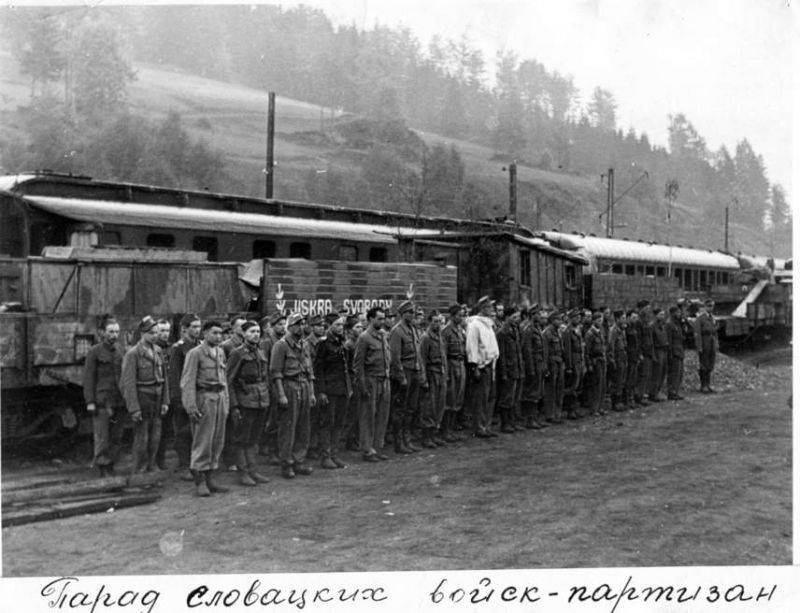
Information